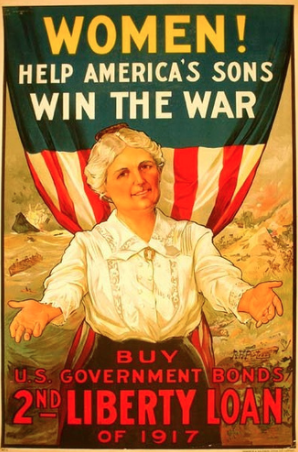
The Flickr account featured quite a variety of posters, and I feel like we all could have chosen any one of them to analyze and plug into the Pearl James introduction. I think James’ point about how poster interpretation poses a challenge is very important. She argues “they cannot be studied in the surroundings in which they appeared, nor can their viewers be called to bear witness to them in any systematic way” (16). More than likely, the posters did not accurately represent conditions or activity surrounding where they were displayed, but I keep looking at this motherly figure in the above image wondering where this type of ad would have been placed to appeal to other maternal wives and mothers. According to James, posters were placed in unchartered territory. Distribution reached a wide audience near “shop windows, banks, schools, churches, libraries, town halls, factories, and recruiting stations, offices and homes; in cities, small towns and rural settings” (10). The white hair and plump body confirmation of this woman suggests she is middle aged with kind facial features, a pleasant smile and loving arms that are open for encouragement. I see this type of ad going up in a church, library, town hall or home as James suggests where mothers frequently travel. This woman does not fit the stereotype of a young, thin woman slaving away in a factory or manufacturing facility for the war. This poster is meant to pull at your heart strings by reminding women in particular that we all have a kind and innocent mother who will take care of “America’s sons” if other women do their part by purchasing a government bond to support the war.
The James introduction addresses Maurice Rickard’s “discernable phrases” or patterns that were documented in national poster campaigns: 1) men and money; 2) help for the fighting man; 3) help for the wounded, orphans and refugees; and 4) calls for women workers, economy in consumption and “austerity” all the way around. This older woman, with her pulled up hair and white blouse, is an example of how the poster is attempting to reach fellow women with a simple, austere appeal. Her image is meant to persuade viewers to trust her. If “posters are designed to appeal quickly to a passing viewer and depend upon a certain instantaneous recognition” (20) then this particular ad is immediately asking us to identify with a mom or grandmother who can care for and heal the male soldiers.
This poster is also indicative of James’ theory that, as an American poster, it is future oriented – portraying the scenario that when the war ends and soldiers return home, they will come home to their mothers’ arms (if they don’t already have a wife, and a lot of them didn’t because they were so young they were not yet married). By using a woman as the primary element of the image, “the American poster portrays comingling across class and gender lines but reinforces a racially hegemonic vision of American citizenship as a white prerogative” (26). This older woman/mother figure supports James’ perspective that “the war brought new meaning even to supposedly timeless female roles” (30). The use of a mother image to suggest motherhood “was reckoned by some as a vital source of national renewal in the face of the war’s human costs” (30). I interpret this as “come to mother, she will give you life again after the war” or “be a mother like this woman and take care of soldiers through the purchase of war bonds. A war scene of soldiers, explosions and sinking ships ravages on in a story sea behind the mother. It is a subtle image meant by the artist to be dominated by the bold stars and stripes of American patriotism along with the mother’s outstretched, inviting arms.
Although Vera, Roland, Edward, Victor and George were all from Britain and not America in Testament of Youth, I think I can see a tie between this poster and their characters, especially the young men who were not married. In the heat of battle after sustaining injuries and realizing death was approaching, there are stories of grown men, strong soldiers calling out for mother, seeking comfort and peace as they take their last breaths. Here she is – this is mother in the poster, ready to give warmth and life. Sadly, Edward and Vera’s mother was emotionally weak and did not project this motherly image the way maybe Roland’s mother, a confident author, would have greeted Roland if he had returned from war.
